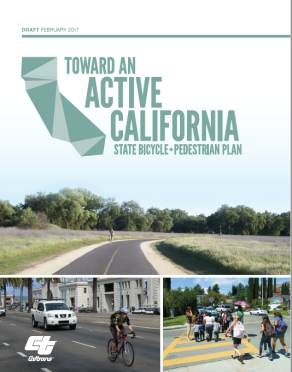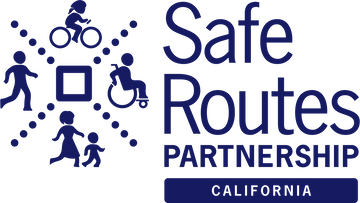
Caltrans has just released a draft of its State Bicycle and Pedestrian Plan and is taking comments until March 10. There will also be several public workshops and a webinar in the coming weeks to receive feedback (dates and times here). The final plan is expected to be released in April 2017.
Public Workshops and Webinar: There will be three in-person workshops around the state. Additional details on these workshops including location information are available here.
- San Jose: Thursday, February 23, 10am-12pm
- Fresno: Monday, February 27, 1-3pm
- Santa Ana: Monday, March 6, 10am-12pm
- Webinar: Wednesday, March 1 , 3-5pm
Comments: There is an online comment tool that allows you to comment on specific provisions of the document. Comments are due March 10.
Plan Features: The plan is entitled Toward an Active California and identifies tools, policies and strategies that Caltrans and other state agencies can take to increase safe walking and bicycling in the State. The Plan is meant as a complement to local and regional plans and efforts already underway, and identifies the State’s role in making it safer and more convenient to walk and bike. It is aligned with other state transportation plans, including the Caltrans Strategic Management Plan (2015) that calls for doubling the rates of walking and bicycling by 2020, and the recently-updated California Transportation Plan 2040.
The plan’s Vision is: “By 2040, people in California of all ages, abilities, and incomes can safely, conveniently, and comfortably walk and bicycle for their transportation needs.”
The Plan has four objectives: Safety, Mobility, Preservation and Social Equity. Each objective has several strategies associated with it to implement the Plan. There are also best practices interwoven throughout the Plan from California communities and other places around the world.
- Safety: Reduce the number, rate, and severity of bicycle and pedestrian involved collisions
- Mobility: Increase walking and bicycling in California
- Preservation: Maintain a high quality active transportation system
- Social Equity: Invest resources in communities that are most dependent on active transportation and transit
Key Highlights: From our quick read of the Plan, there are a few highlighting related to Safe Routes to School:
- The Plan calls for a universal elementary school curriculum for pedestrian and bicycle safety. It pegs the cost of such a program at between $20,000 to $300,000 per school per year, depending on the size of the school. Statewide it would cost around $20 million to $300 million (estimating there are 100,000 schools in the State). (S1.4)
- There is a strong focus on equity throughout the report, emphasizing the State’s most vulnerable pedestrians and bicyclists include children, especially in disadvantaged communities where there are typically more children walking and bicycling to school out of necessity (see Social Equity objective).
- There is a call for greater data collection and standardizing existing methods, so that we can get a better sense of who is walking and bicycling, when/where collisions involving pedestrians and bicyclists are occurring, and what types of improvements will increase level of comfort with using pedestrian and bicycle facilities the most (S3.1, S3.2, M4.1, M4.2, M4.4).
- The Plan recommends greater education and training for law enforcement officers on walking and bicycling (S3.3 and S4.1).
- There is a strategy addressing first and last mile issues with walking and bicycling to and from transit (M2.1).
- There is a recommendation related to school siting and promoting more efficient land use and development (M3.1)
- There are several strategies related to encouragement, including Safe Routes to School, developing model programs and conducting behavior change research (M6).
- The Preservation strategies include a recommendation for pedestrian and bicycle accommodation in construction projects (P1.2)
- The Equity objective includes multiple strategies recommending greater community engagement, technical assistance, model programs and materials, and plans to identifying needed active transportation improvements (E1-E3).
Streetsblog has also posted a detailed analysis of the Plan that is worth reading to gain a better understanding of the Plan.
The full report is available here. Visit the Plan website at www.cabikepedplan.org for updates on public outreach and other information.


